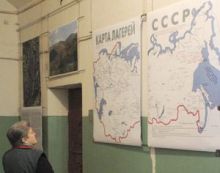LVIV – “One-Way Trip: Kolyma-GULAG-Alaska” is the name of the exhibit by Volodymyr Ohloblin (Kharkiv), Volodymyr Mankuta (Cherkasy), and Andrei Larionov (Magadan, Russia), who brought to Lviv the photos of the places where the traces of the GULAG camps are still preserved. The exhibit consists of large photographs and maps, completed with explanations from historical documents and fiction and authorial commentaries, and tells about the system of Stalinist concentration camps. The authors maintain their aim was to remind that the GULAG must not be forgotten until there is a formal repentance for the crimes of the Soviet regime. The words of Mikhail Tomsky, one of the leaders of the Bolshevist party, serve as the epigraph to the exposition: “Under the dictatorship of proletariat, there can well exist two, three, or four parties, but only under one condition: one party in power, the rest in prison.”
It is a common knowledge that the GULAG (Chief Administration of Corrective Labor Camps and Colonies) was a subdivision of the NKVD, the secret police, later also known as the USSR ministries of foreign affairs and justice. The GULAG was responsible for managing the corrective labor camp system in 1934-60. Special administrations of the GULAG united corrective labor camps in various regions of the Soviet Union: the Karaganda Corrective Labor Camp, or Karlag, the Dalstroy NKVD/MVD USSR, the Solovetsky Corrective Labor Camp (USLON), the White Sea – Baltic Corrective Labor Camp, the NKVD complex, the Vorkuta Corrective Labor Camp, the Norilsk Corrective Labor Camp, etc. All camps had extremely hard living conditions, whereas elementary human rights were flouted, and the most severe punishments were inflicted for slightest misconducts. Mortality rate was exorbitant, due to starvation, disease, and hard labor. According to various sources, nearly 10 million people were sent to this system of “correction labor camps.”
Since the publication of Andrei Solzhenitsyn’s The Gulag Archipelago in 1973, the term GULAG has become a synonym for the NKVD camps and prisons and the totalitarian regime as a whole.
The exhibit “One-Way Trip” is open at the Lontsky Street Prison Museum (1, Stepan Bandera Street) seven days a week, till February 17. The admission is free.







